Tay Sachs Disease Punnett Square

Tay-Sachs illness, a heritable metabolic disorder commonly associated with Ashkenazi Jews, has also been found in the French Canadians of Southeastern Quebec, the Cajuns of Southwest Louisiana, and other populations throughout the world. The severity of expression and the age at onset of Tay-Sachs varies from infantile and juvenile forms that exhibit paralysis, dementia, incomprehension and early on expiry to a chronic adult form that exhibits neuron dysfunction and psychosis.
Tay-Sachs is an autosomal recessive affliction acquired by mutations in both alleles of a gene (HEXA) on chromosome 15. HEXA codes for the blastoff subunit of the enzyme β-hexosaminidase A. This enzyme is found in lysosomes, organelles that pause down large molecules for recycling by the cell. Commonly, β-hexosaminidase A helps to degrade a lipid called GM2 ganglioside, but in Tay-Sachs individuals, the enzyme is absent or present but in very reduced amounts, allowing excessive aggregating of the GM2 ganglioside in neurons. The progressive neurodegeneration seen in the varied forms of Tay-Sachs depends upon the speed and degree of GM2 ganglioside aggregating, which in plow is dependent upon the level of functional β-hexosaminidase A nowadays in the body.
A mouse model has been developed for Tay-Sachs, although its usefulness is limited since Tay-Sachs mice possess a pocket-sized alternative pathway for breaking downwards GM2 ganglioside. Treatment of the belatedly onset form of Tay-Sachs with a ganglioside synthesis inhibitor shows promise. The effectiveness this and other treatments on individuals with the infantile (the most common) form of the disease is extremely limited since the extent of neurological damage prior to birth is unknown. The difficulty in reversing such harm will brand it hard to develop an effective treatment for the infantile class of the disease. It is hoped, however, that the latter onset forms of Tay-Sachs may show responsive to handling, and such treatment combined with the Dna and enzymatic screening programs currently in use will atomic number 82 to the eventual control of this illness.
Related diseases
Tay Sachs Disease Punnett Square,
Source: https://www.ncbi.nlm.nih.gov/books/NBK22250/
Posted by: kentunclefor.blogspot.com


0 Response to "Tay Sachs Disease Punnett Square"
Post a Comment